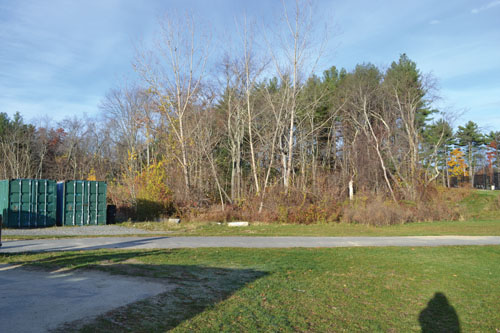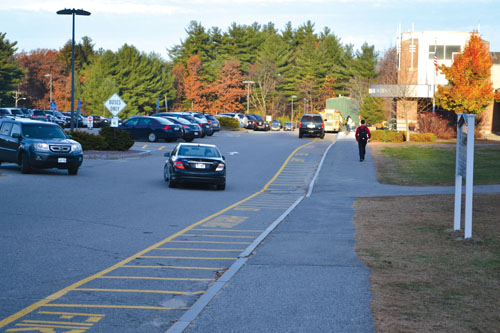
By Ann Needle

student lot where administration is considering adding parking.
Ann Needle
The impact of Nashoba Regional High School’s growing number of students is spreading outdoors. With traffic patterns and parking becoming an issue, last Thursday morning Nashoba Superintendent Michael Wood conducted a public tour of the parking areas around the building, discussing potential solutions for adjusting that space.
Those heading to a sporting or school-wide event at NRHS know not to be late, or risk parking on the lawn, on narrow Green Road, or (if available) the student parking lot on the far side of the building. But, for administration, the concern goes beyond convenience.
School Resource Officer Sandra Lawton said, “There are instances when we’ve had a full student parking lot. We would not have been able to get emergency vehicles in in an emergency.” She explained that this would mean some building entrances would be inaccessible to first responders, an unacceptable situation in a large-scale emergency.
Safety was Wood’s first discussion point, emphasizing that separating bus and car traffic is Nashoba’s top priority. Observing the before-school bus and car drop-off with about 10 Nashoba residents, he pointed out cars passing a student transport van with its lights flashing, something he maintained happens frequently in the narrow lane in front of the school. Vehicles were pulling up to the front of the school behind parked buses, though official student drop-off is one row away.
Where buses (or drop-offs) should be routed to depends on where Nashoba can reconfigure its exterior for more parking spaces, according to Nashoba Director of Facilities Bill Cleary. The buses cannot fit in the lane between the back of the school and the turf field, he added.
One solution Cleary mentioned could be to use the empty space abutting route 117 to reconfigure the bus lane and drop-off with what is known as the staff parking lot, which lies between that space and the drop-off corridor. Those attending the walk agreed it would give the high school the chance to keep cars from parking on the grass surrounding staff parking, which can block visibility for drivers leaving and entering.
Wood said that another possibility was paving over the current tennis courts — to the right of the school, overlooking Green Road — and gaining 60 spaces. (New tennis courts should be built near the athletic fields by next school year.) Ideally, there would be a separate entrance to this lot leading in from Green Road, he noted. This also would be near the auditorium, front entrance, and gym, where guests tend to park.
Some of the tour residents, having houses on Green Road, balked at the suggestion. Though the new lot could help keep cars from parking on that narrow road, these residents voiced concern that it also would increase traffic flow. One resident told Wood, “Think of what this would do to your home.”

Student Lot Questioned
Looking to the left side of the school, NRHS Principal Dr. Parry Graham estimated that the student parking lot is short a total of about 40 spaces. Though there were a number of empty spaces Thursday morning, Graham explained that, as more students earn their drivers licenses by spring, the school grants more parking passes. The lot then reaches its 240-vehicle capacity, with NRHS rejecting about 40 student requests for passes.
One very likely possibility for more parking is the empty space between the student lot and the athletic fields, according to Bill Cleary. This could be done by removing the retaining pond, and without disturbing the wetlands closer to 117, he said.
Throughout the tour, residents asked why those attending school events don’t fill up the student lot before resorting to makeshift spaces on Green Road and on the grass. “Can’t they walk?” commented one resident, referring to the space between the student lot and the gym/auditorium area on the right. Assistant Superintendent George Kind replied, “It’s just human nature.”
Wood noted the number of new spaces created for the entire school would depend on what parking solution is adopted, which would hinge on factors such as cost and any needed town approvals. He added that Nashoba is aiming to have a solution in the works within the next 3 to 7 months, with some preliminary money built into the upcoming budget to get started on construction.